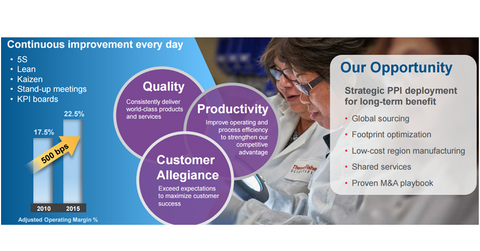Can Thermo Fisher’s PPI Business System Continue to Drive Growth in 2016?
The PPI system has helped nourish strong top-line growth across Thermo Fisher’s businesses while boosting margins.
July 13 2016, Updated 11:04 a.m. ET

Overview
PPI business system efficiency and savings
Thermo Fisher’s PPI productivity savings improved over the years, from $85 million in 2012 to $170 million in the year 2015. Various PPI processes, projects, and events have been undertaken by the company, including 5S, Kaizen, stand-up meetings, and KPI boards. The company aims to deploy its PPI strategically across its businesses for the company’s long-term growth through global sourcing, footprint optimization, shared services models, and low-cost region manufacturing.
Specifically, PPI focuses on customer allegiance, quality, and productivity to improve processes, increase operational efficiencies, and offer quality products to customers. The system remains a key growth driver for Thermo Fisher Scientific and is expected to result in better operational efficiencies and higher revenue growth and profitability.
Operational discipline is one of the main pillars of growth for a company, and a number of other major companies in the medical device industry, including Abbott Laboratories (ABT), Medtronic, and Becton Dickinson (BDX), have also established processes and procedures for effective operational performance and to spur growth.
Notably, the iShares S&P 500 Growth ETF (IVW) has ~0.42% of its total holdings in Thermo Fisher Scientific.
